The Huawei Mate 8 Review
by Andrei Frumusanu on January 5, 2016 1:00 PM EST- Posted in
- Mobile
- Smartphones
- Huawei
- Cortex A72
- Kirin 950
- Mate 8
- CES 2016
Battery Life
Continuing to the battery life benchmarks we should expect the Mate 8 to perform very well, thanks to the high efficiency of the Kirin 950, an LCD screen as well as the 4000mAh / 15.2Wh large battery.
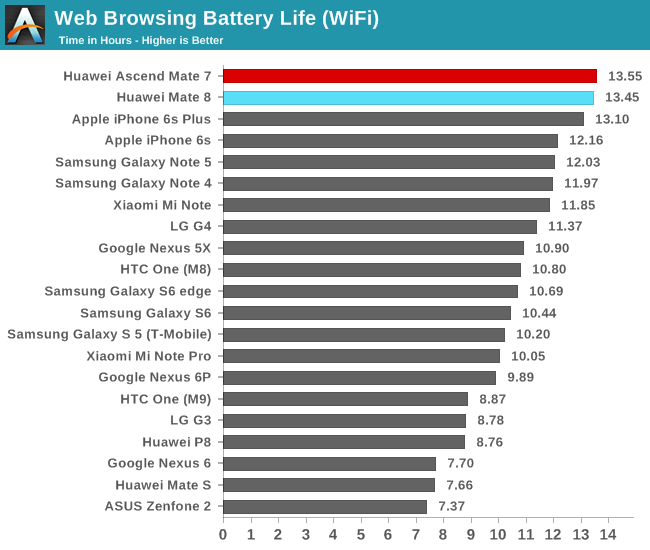
Starting off with our WiFi web-browsing test we see the Mate 8 just get short of 13.5h of battery life. The interesting comparison is here to last year’s Mate 7 as it seems the actually last just as much. This may point out that the screen efficiency measured in our display power testing was maybe correct and the Mate 8 is less efficient. Another aspect is that the Mate 8’s overall platform power consumption hasn’t seen much improvement and thus still represents a large barrier for battery life.
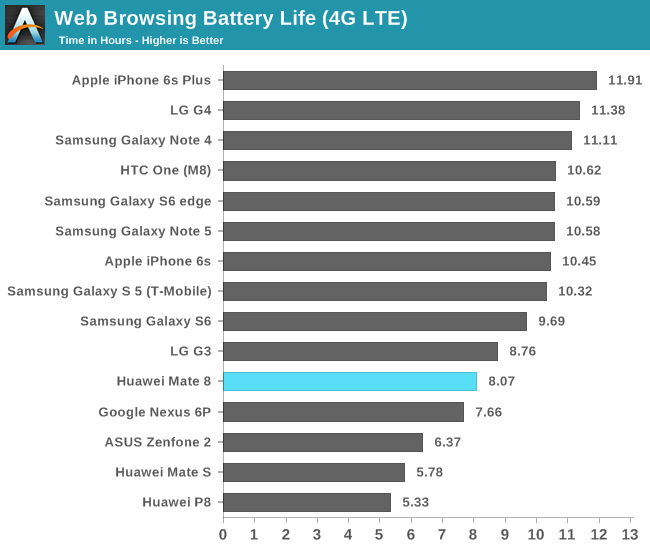
On the 4G LTE test we see that the Mate 8 loses out its advantage over the competition. Again I’m testing under rather mediocre signal conditions so it’s not a valid apples-to-apples comparison to devices reviewed by Joshua or Brandon, however when comparing it against for example such as the Nexus 6P which was tested under the same conditions we see that the Mate 8 faces a much larger battery life degradation going from the WiFi to the LTE test. The reason for this can only be that the Kirin 950’s modem and RF back-end just aren’t as efficient as Qualcomm or even Samsung’s.
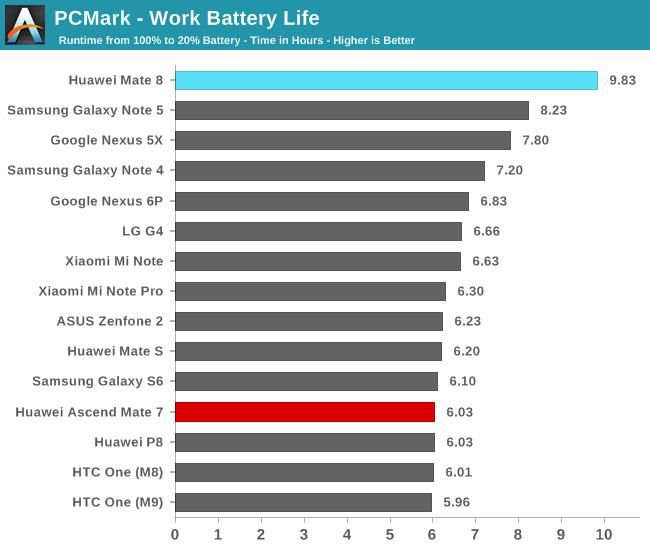
While the web-browsing tests didn’t represent a large improvement for the Mate 8, we see PCMark put the phablet as the current undisputed leader among high-performance devices. Here the difference to the Mate 7 is almost 4 hours, or around a 65% increase in battery life. The increase is most certainly linked to the new SoC’s power efficiency.
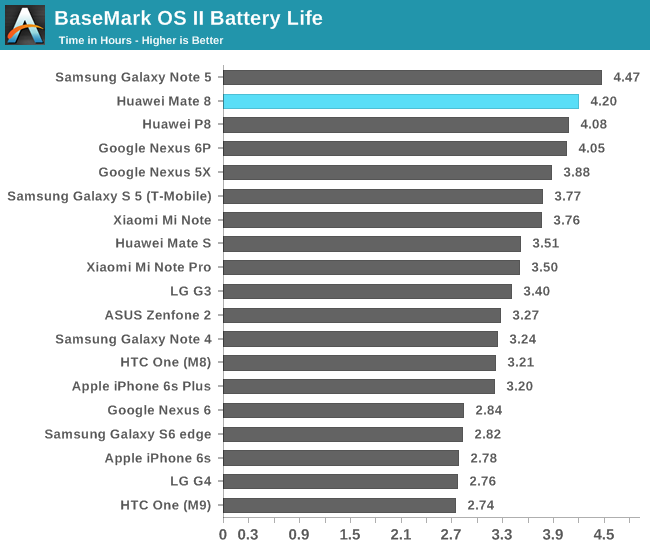
BaseMark OS II’s battery test is more of a maximum load type test that depends on the allowed maximum TDP of the phone. With a 15.2Wh battery and a runtime of 4.2h we see an average consumption of 3.6W, roughly the same amount of power that I saw that the device was able to sustain in our CPU thermal test.

Finally the GFXBench battery test shows that the Mate 8 doesn’t show very good battery life but this is a two-edged sword. As we’ve seen in the GPU section the SoC hardly throttles under heavy GPU load and thus retains its maximum performance for the duration of the test. Considering that the Mate 7 slowed throttled down to 9-10fps and the Mate 8 does not go under 40fps, it still shows that the Mate 8 is twice as efficient as the Mate 7 even though overall battery life is almost twice as short.
At 200 nits the Mate 8 averages an idle power consumption of 989mW and we saw that system load power for the T-Rex test is 3.64W. 3 hours battery runtime averages 5W of power, near the 4.6W we theorized. The small difference may be due to the overhead of actually running the on-screen test and thus also not able to show the DDIC’s savings thanks to PSR due to continuously changing screen content.
Overall I’ve been extremely impressed by the Mate 8’s battery life. In everyday usage this is the longest-lasting device I’ve had the opportunity to use. The Kirin 950’s efficiency is outstanding and is truly able to earn its place among the top for this generation. It seems the Mate 8’s limiting factors are related to the screen and general platform base power consumption, something that Huawei may be able to improve in future devices and thus get even better value out of the Kirin 950.
All being said, if you’re looking for a long-lasting device, you can’t go wrong with the Mate 8.
Charge Time
The Mate 8 advertises fast charging out of the box so that even considering it having a large 4000mAh battery, it should still be fast to fill up when in need. The stock charger is a 9V/2A (18W) unit. I’m not sure if the charging enumeration protocol is based on Quick Charge or Adaptive Fast Charging, but it was able to enable fast-charging on Samsung phones while the Mate 8 didn’t fast-charge on Samsung’s charger, meaning the Huawei charger is likely a Quick Charge unit and the Mate 8’s PMIC and voltage negotiation IC seems to only accept Quick Charge.
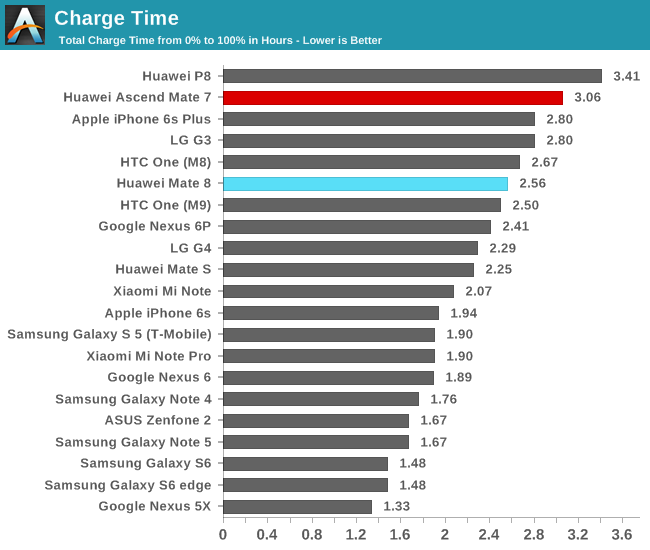
As we see in the charge graph, the Mate 8’s battery cell gets charged at up to 11.5W during the fast-charging phase, being able to reach 80% in 68 minutes around little under 40% charge for each half hour of charging. The last 20% takes up to another 70 minutes as the device switches over to trickle-charging.
While the Mate 8 ends up with total charge time of 2.56 hours, what counts is that the initial 80% of battery capacity can be charged very fast so the Mate 8 is no slouch in this metric.


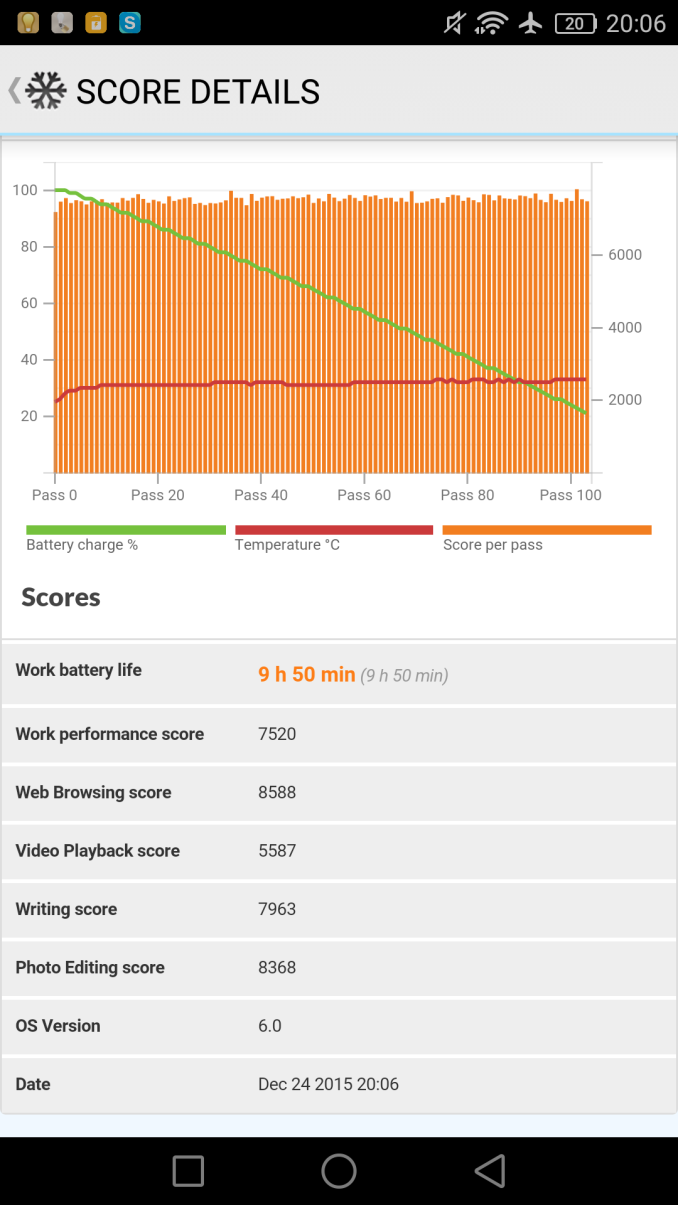
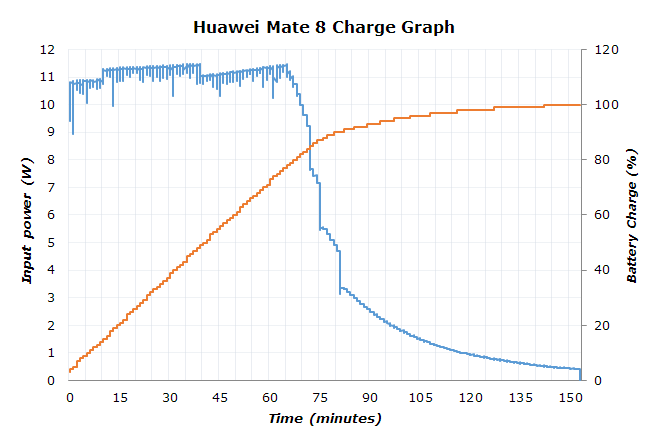








116 Comments
View All Comments
Ethos Evoss - Thursday, January 7, 2016 - link
Test result battery stay last a quarter of day.. on s plus slightly more..s.yu - Saturday, January 16, 2016 - link
Not enough people realize you're a stupid Huawei fanboy so they still bother trying to speak sense into you, what a waste of time.Ethos Evoss - Sunday, January 24, 2016 - link
Jesus Christ you again ???I don't even own huawei phone there is no any waste time ..why u wasting time here replying u mental.. :DEthos Evoss - Wednesday, January 6, 2016 - link
@Andrei FrumusanuI must say that THIS TIME Andrej u made an WONDERFUL, TRUTHFUL , NOT biased review for Huawei product ! WELL DONE !
I am starting like anandtech slowly ..
But one thing I need con.. ; Why such MEGA TERA in depth ? Isn't it too much ? silly ;)
Do we really need those cpu's or gpus instructions and those not really friendly graphs just to make call or browse net , play vid ? This review was very very in -depth than previous any smartphone review.. But still great .. I admire those ,who is truthful and real and this time you were..
But overall huawei disappointed me in more aspects..
Disappointments ;
* Yes agree very thick black borders around the screen .. it is just horrible huawei NEVER been like this .. Only solution is going for black screen..
* The display is really bad I can't believe , I had P8 which has the SAME mauf. same technology so how can be mate 8 screen so bad ? P8 is JDI IPS NEO too ...should be the same.. weird
* The battery is Ok thought will be better than Mate7 a lot more.. Can't understand how Mate 2 has the BEST battery life from all smartphones in the world.. But cannot believe that there was better battery life with iphone 6.. I DON'T believe that .. That's on paper DEFO not real world ! So may iphone 6 ppl wouldn't complain !
* The pictures are bad .. disappointment !
* The video recording is just horrible blurred not sharp .. Only one thing slightly saved it that 1080p 60 real motion .. that was cool I would record ONLY with 60fps.
*NO USB C and no fast charge very bad !
And Huawei phones prices increased dramatically so it is NOT Huawei as I knew this back in day !!!
I just purchased S6 Edge just for £280 from aliexpress and advantage is that it has nice brightest screen from all smartphones .. and very good whites .. (in the pas it was disaster with their whites.. looks like samsung learned )
boostern - Thursday, January 7, 2016 - link
Yes we need more reviews like this one. If you want want to read reviews like "camera OK, display mmm, CPU Antutu over 9000!" there are plenty out here. I literally cum when I read a review such deep like this one.Ethos Evoss - Thursday, January 7, 2016 - link
''cum'' u DAFT ..s.yu - Saturday, January 16, 2016 - link
This is Anandtech, you read the most detailed review anywhere. The second most detailed is Notebookcheck, they release more reviews but they're not as detailed. As for the "impression"s and "hands-on"s they're everywhere.ManuLM - Thursday, January 7, 2016 - link
Strange: on display page, the luminance - Power curve shows 821mW for 200CD/m2 but in the table just below you rate it as ~419 mW. Typo, or I did not understand the table "Screen Luminance Power Efficiency 100% APL / White" ?Andrei Frumusanu - Thursday, January 7, 2016 - link
The power curve is power of the whole device, to just look at luminance efficiency I use the projected baseline at 0 nits to get a value for the backlight power only.zodiacfml - Thursday, January 7, 2016 - link
One trick pony with a high price.